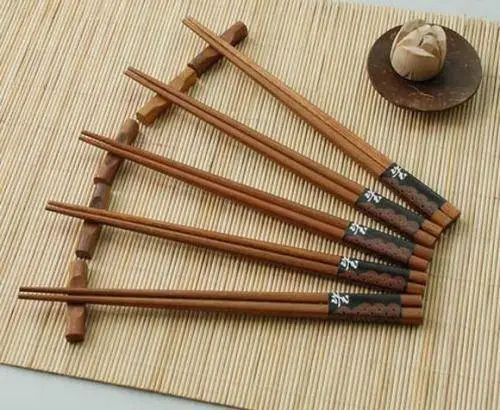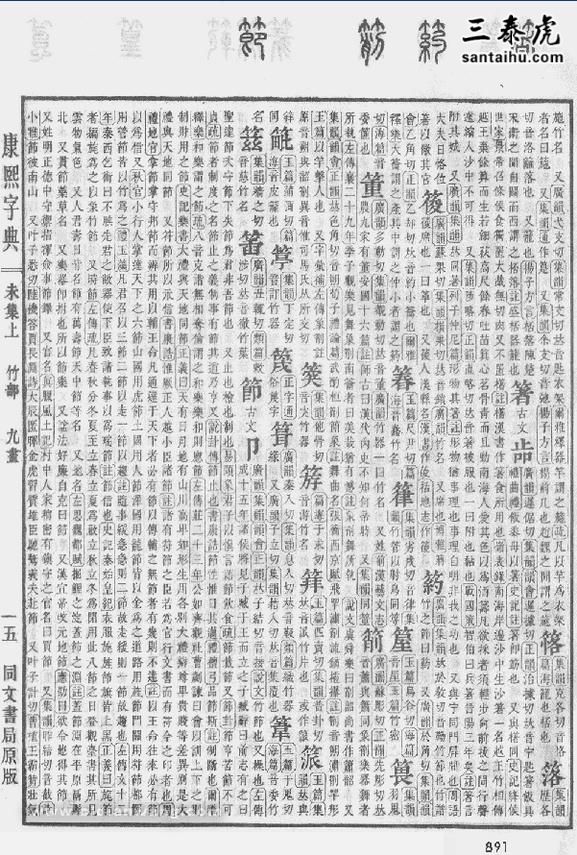Why do Chinese use "筷" as the character for "chopsticks," while Japanese, Korean, and Vietnamese all use "箸"?
为什么中国人用“筷”来表示“筷子”,而日本人、韩国人和越南人用“箸”?

以下是Quora网友的评论:
Joe ing
Both 筷 and 箸 mean chopsticks in Chinese. If you talk to a educated people about these two characters, they may understand without any problem. But 筷 is more commonly used in modern Chinese (白话文), while 箸 is more commonly seen in ancient Chinese (文言文). Chinese characters were introduced to Japanese to annotate their language in Tang dynasty. I guess at that time 箸 was more popular than 筷.
Proof: 停杯投箸不能食,拔剑四顾心茫然。(行路难 Steep roads,李白 LI Bai,唐 Tang Dynasty)
There is an anecdote about 筷 and 箸. (My primary school teacher taught me this, might not be true, but it is a quite popular explanation in China).
“筷”和“箸”在汉语中都是筷子的意思。如果你和一个受过教育的人谈论这两个汉字,他们一听就明白。但是“筷”在现代汉语中更为常用,“箸”较常出现在古代汉语中。日本在唐代引入汉字。我想在那个时候,箸的流传度比筷更广。
证明:停杯投箸不能食,拔剑四顾心茫然。(唐代李白的《行路难》)
我可以分享一则关于筷和箸的趣闻。(我的小学老师跟我说的,未必是真事,但在中国流传很广)。
筷 has the same pronuciation as 快, which means “fast”; while 箸 has the same pronouciation as 住, meaning “stop”. People who work on the ship, e.g. sailors, businessmen, regard 箸 is of bad luck to their trip ( OMG, the ship will stop), but 筷 is more fortunate (the ship goes fast). So they started to call chopsticks 筷. Gradually, this convention is spread to the entire China.
Edit: I am a northern “barbarian” Chinese who speaks only Mandarin. I didn't know 箸 is still used in Chinese dialects until I read the other's answer.
“筷”和“快”发音相同,意思是“速度快”;而“箸”的发音与“住”相同,意思是“停住”。在船上工作的人,比如水手、商人,认为“箸”会给他们的出行带来厄运(天哪,船要停了),但“筷”会带来好运(船走得很快)。所以他们开始称筷子为“筷”。渐渐地,这个习俗传遍了整个中国。
编辑:我是一个只会说普通话的北方粗人。我看了别人的回答才知道有些中国方言至今还延用“箸”这个字。

Jason Li
Because the Japanese, the Koreans, and the Vietnamese have all adopted the word Zhù (箸) well before the use of Kuài (筷) became prevalent in China, and they saw no use to change to the new character.
Zhù (箸) is a classical Chinese character, dating back to some of the earliest records in Chinese. For example, in the Confucian Canon Book of Rites (禮記/曲禮上) from around 300BCE, it stated:
饭黍毋以箸
Do not use chopsticks in eating millet.
因为早在Kuài(筷)在中国流行开来之前,日本人、韩国人和越南人就已经使用Zhù(箸)这个字了,他们觉得没必要改用这个新字符。
Zhù(箸)是一个古汉字,可以追溯到中国最早的一批文字记载中。例如,在公元前300年左右的儒家礼典《礼记》中就写到:
饭黍毋以箸
不要用筷子吃小米。
Kuài (筷) evolved much later in China, first appeared around Ming dynasty (1368–1644). It came up in common colloquial usage in popular novels, such as Chapter 63 of Outlaws of the Marsh (水浒传 (70回本)/第63回):
梁中书听得,諕得目瞪口呆,杯翻筷落。
Minister Liang was stunned by what he heard, cups were flipped over and chopsticks were dropped.
Kuài(筷)在中国出现的时间要晚上得多,最早出现在明朝(1368-1644)左右。在通俗小说中经常出现“筷”字,比如《水浒传》(70回本 / 第63回):
梁中书听得,諕得目瞪口呆,杯翻筷落。
梁中书被听到的事惊得杯子翻了,筷子也掉了。
Kuài (筷) didn’t enter the official vocabulary for quite a long time, hence it didn’t appear in Kangx Dictionary (康熙字典) in 1710. Zhù (箸) on the other hand, did make it to the dictionary:
Contemporary sources in the Ming Dynasty recorded the switch from Zhù (箸) to Kuài (筷) , such as Lu Rong’s work Random jottings from bean garden, Chapter 1 (菽園雜記/卷01) circa 1480:
民間俗諱,各處有之,而吳中為甚。如舟行諱「住」,諱「翻」,以「箸」為「快兒」…
Kuài(筷)在很长一段时间内都没有成为官方用词,所以没有出现在1710年编撰的《康熙字典》中,但Zhù(箸)确实被收录进了词典:
明代的资料记录了从Zhù(箸)到Kuài(筷)的转换,如1480年左右陆荣在《菽園雜記》(卷/ 01)种就写道:
民間俗諱,各處有之,而吳中為甚。如舟行諱「住」,諱「翻」,以「箸」為「快兒」…
There are numerous taboos among the common people, and they are particularly prevalent in Zhejiang area. Examples are when travelling by boat, they avoid homophony of “stop” or “flip over”, hence saying “kuài-er” instead of “zhù”…
Therefore, it appears that the Japanese, the Koreans, and the Vietnamese have all adopted the word Zhù (箸) well before the use of Kuài (筷) became prevalent in China.
Chances are that when Kuài (筷) became prevalent in China, the Japanese, Korean, and Vietnamese all saw no use to change to it, as Zhù (箸) was still recognised in China, particularly around official court usage.
民间有很多忌讳,在浙江地区尤其普遍。例如,乘船旅行时不能说“住”或“翻”的谐音,因此用“快儿”代替了“箸”……
因此,Kuài(筷)在中国流行开来之前,日本人、韩国人和越南人似乎就已经使用Zhù(箸)这个字了。
很有可能,当Kuài(筷)在中国流行开来的时候,日本人、韩国人和越南人都觉得没必要改用这个字符,因为中国,尤其是在宫廷用语中,仍然保留了Zhù(箸)字。
Yilun Li
See other answers, you have already know how to pronounce the two characters.
Zhu was used in china for chopsticks, but not today
Anciently, many people are superstitious, the old character for chopstick, due to its pronunciation, the fishermen does not like it, it pronounce “Zhu”, there is another character means “stop” which has the same pronunciation. Therefore, using this was considered a taboo in the range of fishermen. Somehow, to avoid this, they started using “Kuai”, because there is a character “快“ in Chinese language means “move fast”. Then it feels like in order to avoid the taboo, move is not enough, they want “move fast”. Compare “快” and “筷”, it is easily to see this character is the lower half of “筷”.
如果看过其他答案,你肯定已经知道这两个字如何发音了。
“箸”在中国曾用来指代筷子,但现在不用这个字了。
古代人大多十分迷信,旧时指代筷子的“箸”字,渔民因其发音“zhu”不喜欢它,“箸”还有一个同音字,意思是“停”。所以,渔民们把这个字视为忌讳。
为了避开这个字,他们开始用“筷”取代“箸”,因为“筷”也有一个同音字“快”,意思是“快速行进”。
大概是为了避讳,渔民们认为移动还不够,他们希望能“快速行进”。看看“快”和“筷”,你一眼就能看出“快”正是“筷”的下半部分。
(A litterateur from imperial Qing dynasty of China said: “起於吴中。凡舟行讳 ‘住’ 讳 ‘翻’,故呼 ‘箸’为 ‘快子’” , which is cited from 《菽园杂记》, authored by 陆容of Great Ming Empire of China)
So far we are in the middle of the discovering. We have known why the lower half exst, but the upper half is not explained yet.
(中国清朝的一位文学家曾说:“起於吴中。凡舟行讳 ‘住’ 讳 ‘翻’,故呼 ‘箸’为 ‘快子’”,这句话出自明代文学家陆容的《菽园杂记》)。
至此我们仍未寻得全部答案。我们已经知道为什么“筷”的下半部分是“快”,但对其上半部分的由来还未了解。
Our ancestor invented so many characters, to describe everything they saw, after thousands years, the shape and style changes, base on their former shape, only in order to make them easier to use. However, the way we combine, separate, transform never change. “竹” in Chinese means bambo. Because it is usually the material to make chopsticks, especially in the ancient time (Now we have metal, plastic, and very few for the wealthy uncivilized individuals, they use ivory chopstick). Therefore, this character was transformed, and combined with “快” and “者”, and became 筷 and 箸.
For some other reason, the new form of chopstick becomes popular. I don’t know much else
我们的祖先发明了这么多汉字来描述他们的见闻,几千年后,为了方便使用,汉字的字形在原有基础上逐渐发生变化,但组合、分割、转化的方式从未改变。“竹”在汉语中表示竹子。人们通常用竹子来制作筷子,尤其在古代时期(现在我们也会用金属、塑料来制作筷子,有些有钱的粗人们甚至会用象牙做的筷子)。所以“竹”字被转化成“⺮”,并和“快”、“者”结合,构成了“筷”、“箸”。
出于某些原因,这个指代筷子的新字越来越普及了。至于其他的,我也不太清楚了。
Zhengfeng Tang
I came from south part of hunan province which located in middle south china…
My home town speaks a very old dialect which is the mother tongue of around 400 000 locals, and I can see that my mother tongue contains lots of old Chinese, including this, we Speak it exactly same as 箸~zhu.
我来自湖南省南部,湖南省位于中国的中部…
当地还在使用一种非常古老的方言,大约是40万当地人的母语,在我的母语中可以发现很多古汉语,包括这个“箸”字,其在当地方言中的发音和“祝”一模一样。
I donot Speak Japanese but sometimes I watch Japan NHK vedio and I can find some similar pronunciation between Japanese and my mother tongue, such as 说 which pronunce as WA.
when I was in college one of my teacher is linguist, she studied my mother tongue for a long time and said it keeps lots of old Chinese pronunciation.
我不会说日语,但我有时观看日本NHK的视频,发现日语和我的母语之间有一些相似的发音,比如“说”这个字,我们的发音都是WA。
我上大学时有位老师是语言学家,她对我的母语进行了长时间的研究,说其中保留了很多古汉语的发音。
Taurant Nguyen
We pronounce 箸 as đũa similar to Old Chinese reconstructed pronunciation /*das/ and also have Han Viet pronunciation “trứ, trợ” or similar to Middle Chinese reconstructed pronunciation /ɖɨʌH/. Most of Vietnamese think “đũa” is pure Vietnamese and “trứ, trợ ” is Han Viet pronunciation.
我们的发音为đũa,类似于古汉语的发音/*das/,汉越语中的发音是/trứ, trợ/。大多数越南人认为“đũa”就是纯正的越南语,而“trứ, trợ”是越南语的汉音。
From Wikipedia example
我夹箸面畀你试下吖
Ngã giáp “trợ” miến tí nễ thí hạ a (Han-Viet transliteration)
Ngo5 gaap3 zyu6 min6 bei2 nei5 si3 haa5 aa1. [Jyut]
wǒ jiā “zhù” miàn bì nǐ shì xà ā (Mandarin)
I'll get a chopstickful of noodles for you to try.
举个维基百科的例子
我夹箸面畀你试下吖
Ngã giáp " trngui " miến tí nnguyen thí hhti(汉越音译)
Ngo5 gaap3 zyu6 min6 bei2 nei5 si3 haa5 aa1。(Jyut)
wjiji ā“zhù”miàn bì n′shì x<s:1> ā(普通话)
我夹一筷子面条给你尝尝。
Meng
In ancient China, people always called chopsticks "箸".But by the Ming Dynasty, the emperor's surname "朱" was pronounced the same as "箸",The emperor's surname needs to be taboo, otherwise it will be considered offensive.This is why they use "筷" instead of "箸".
中国古代,人们都称筷子为“箸”。但到了明代,因为皇帝姓“朱”,发音和“箸”相同,人们必须避讳皇帝的姓氏,不然就是大不敬。所以人们用“筷”代替了“箸”。
Amanda Koh
Not all Chinese languages use "筷" to mean chopsticks. Some Chinese languages like Mandarin and Cantonese use "筷". Others like Min-nan still use "箸".
并不是所有的中国语言都用“筷”来表示筷子。普通话和广东话会说“筷”。其他方言,比如闽南话就还是说“箸”。
J. Chin
I have read that 筷 came around because 箸 was too similar to 住, which can mean a number of things, including “live” or “stop” (although in historical context, I’m not sure if they had this ambiguity). But I know that last thing you want to do is to stop eating.
I no longer have the book I found this information in, but it’s by Endymion Wilkinson, titled Chinese History: A Manual.
我之前看过一本书,书中提到“筷”字之所以出现,是因为“箸”和“住”太像了,而“住”有很多意思,包括“居住”或“停住”。但我知道你最不想做的就是不吃东西。
我已经找不到那本书了,但我记得作者是Endymion Wilkinson,书名是《中国历史:一本手册》。
Kepha Hor
Hakka speakers also use a word cognate to 箸. (zhu—fourth tone in Mandarin). It represents an earlier stage of what some capital region of China spoke. Perhaps this is what they used in the vicinity of Chang’an back in early Tang times.
客家人也会用到一个跟“箸”同音的词(发音同普通话的zhu),代表了中国某些首都地区所用方言的早期阶段。也许这就是唐代初期长安附近曾经流行的方言。
Andrew Yeoh
It depends on where u r from.
As southern Chinese, we use “箸” (dǚ) in our Chinese dialect and turn to “筷” when speak Mandarin.
Kanji in Japanese, Korean and Vietnamese are related to ancient Chinese or southern Chinese dialects, so it is not a surprise.
这取决于你来自哪里。
作为南方人,我们说方言时会说“箸”(发音:dǚ),说普通话时会说“筷”。
日语、韩语和越南语中的汉字和古代汉语或中国南方方言有关,所以这不足为奇。
Luwiki Jerome
Language is always changing.
“箸” is still in Chinese daily life usage as a measure word, to describe a bundle of noodles or something picked up by chopsticks.
一著麵條,
语言是不断变化的。
在中国人的日常生活中,仍然会把“箸”当做一个量词来用,形容一捆面条或用筷子夹起来的东西。
比如:一著麵條。
Dingsan MU
This is similar to dog 狗、犬.
In Chinese we use both, 狗 is more in oral and modern language、犬 is more in traditional official writing language.
But Japanese use more 犬, that is because that Japanese had been under traditional Chinese influence.
箸 has been used in traditional writing Chinese. If you write a traditional style texte, you’d better use 箸. But for modern time, oral and modern Chinese use absolutely 筷子.
这就类似于“狗”和“犬”。
在汉语中,这两种说法可以。在口语和现代汉语中“狗”更常用,而“犬”更多地用于古代的书面语言中。
但是日本人更常用“犬”字,因为日本人深受中国传统文化的影响。
“箸”是古代书面语。如果你想写古文,最好使用“箸”字。但现如今在口语和现代汉语中,肯定会用“筷子”。
Trịnh Hà Thu
Well,
Vietnamese don’t use "箸" now. Vietnam alphabet uses Latin script, with some modification.
嗯,越南人现在不用“箸”了。越南字母已经改用拉丁字母了,稍微做了一些调整。
此文由 三泰虎 编辑,未经允许不得转载!:首页 > 问答 » 为什么中国人用“筷”来表示“筷子”,而日本人、韩国人和越南人用“箸”?
 越南人如何看待被法国殖民的历史
越南人如何看待被法国殖民的历史 韩国人后悔弃用汉字吗
韩国人后悔弃用汉字吗 中国人为什么不用铁质筷子呢?这样可以避免砍伐树木
中国人为什么不用铁质筷子呢?这样可以避免砍伐树木 泰国人和越南人如何看待彼此
泰国人和越南人如何看待彼此 中国人学日语和日本人学汉语,谁更容易
中国人学日语和日本人学汉语,谁更容易 越南人认为10年后越南会比泰国更发达吗
越南人认为10年后越南会比泰国更发达吗 在中国取得医学博士学位、汉语流利的外国人毕业后能否进入中国医院工作
在中国取得医学博士学位、汉语流利的外国人毕业后能否进入中国医院工作 美版知乎:有些人说汉字是韩国人创造的,是真的吗
美版知乎:有些人说汉字是韩国人创造的,是真的吗